Friday, July 6th 2012

GIGABYTE Launches World's First Fully Certified Dual Port Thunderbolt Motherboards
GIGABYTE TECHNOLOGY Co. Ltd., a leading manufacturer of motherboards and graphics cards, today announced the latest GIGABYTE 7 series motherboards, the very first to offer fully certified dual onboard Thunderbolt ports. Capable of connecting up to 12 devices plus 3 digital displays simultaneously, with breathtaking data transfer speeds that can transfer 1 TB of data in only five minutes, GIGABYTE Thunderbolt motherboards offer the fastest connection interface ever on the desktop PC.
GIGABYTE Thunderbolt motherboards allow users to daisy chain up to 12 devices simultaneously via an incredible bi-directional 10 Gbps data pipeline that includes both PCIe and DisplayPort traffic. GIGABYTE Thunderbolt motherboards redefine desktop PC connectivity to make it far easier to connect multiple high speed storage devices and HD displays to your PC than ever before."It's easy to see how our unique dual port Thunderbolt implementation simply offers more," commented Henry Kao, Vice President of GIGABYTE Motherboard Business Unit. "We're the only motherboard vendor currently offering DIY PC builders the absolute maximum in terms of device connectivity."
"Thunderbolt technology represents a leap in performance and simplicity for media creators and entertainment enthusiasts," says Jason Ziller, Intel's director of Thunderbolt marketing. "We are pleased to be working with GIGABYTE as they bring the first dual Thunderbolt port motherboard to market. It's a great example of what Thunderbolt makes possible."
GIGABYTE Dual Thunderbolt motherboards open up a wealth of new possibilities regarding high-performance storage devices. GIGABYTE has worked closely with several leading device partners, including Promise Technology, LaCie, BlackMagic, Western Digital, Seagate, Elgato, CalDigit and cable manufacturer Sumitomo:
"Working with GIGABYTE has been very exciting," said Kosta Panagos, Director of Creative Marketing, at CalDigit. "GIGABYTE's new line of Intel 7 series motherboards featuring dual Thunderbolt ports, will usher in a new era of flexibility to the PC platform. It is also a perfect match with CalDigit's new T1 and T2 Thunderbolt drives which provide professional level performance on all platforms at consumer prices, a feat that was previously unattainable, thanks to GIGABYTE and Thunderbolt technology."
GIGABYTE's new dual port Thunderbolt motherboards are an exciting innovation, giving incredible performance and are perfect for video and film professionals using Thunderbolt and the PC," said Grant Petty, CEO, Blackmagic Design. "Customers using our wide range of Thunderbolt devices will now be able to choose to work in whatever format they need, giving them the flexibility to build whatever production and post production workflow they need.""In line with GIGABYTE and its dual on board Thunderbolt ports, WD's My Book Thunderbolt Duo offers dual Thunderbolt ports for amazing creative flexibility while allowing daisy-chaining of up to six My Book Thunderbolt Duo drives or other high performance peripherals for fast and efficient workflow," said Craig Davis, Director Sales & Marketing, Retail Division, Western Digital Asia Pacific & Japan Region.
"Thunderbolt technology is a fantastic way to deliver both data and display via one interface. It provides unparalleled performance and plenty of flexibility," said Leo Paskin, Product Marketing Manager at Seagate. "With the ability to daisy chain up to 12 devices on GIGABYTE's new dual port Thunderbolt motherboards, you can turn a desktop PC into a central device hub by plugging in a single cable!"
"As the first Intel certified cable vendor, Sumitomo is delighted to see GIGABYTE bring the first dual port Thunderbolt motherboard to market, creating the ultimate connectivity for desktop PCs," commented Motoi Matsuo. "These new Thunderbolt motherboards are also the perfect fit for Sumitomo's exclusive high speed 20m optical cables."
"Thanks to their dual Thunderbolt ports, Gigabyte's new 7 series motherboards deliver unbeatable flexibility", says Adam Steinberg, Vice President Marketing at Elgato. "The unique dual port feature enables users to combine multiple portable Thunderbolt devices like the powerful Elgato Thunderbolt SSD."
"LaCie is pleased to see GIGABYTE announce Thunderbolt technology on their lasted motherboards," said Erwan Girard, Professional Business Unit Manager, LaCie. "The time is now for demanding PC users, especially digital content creators, to experience the unprecedented speeds and advantages enabled by Thunderbolt Technology. The desire for computers and peripherals to keep up with their work flow is a concern of the past."
Dual Thunderbolt - Fast, Flexible and Simple Connectivity for your Motherboard
GIGABYTE Thunderbolt motherboards are the first to be certified by Intel featuring dual Thunderbolt ports directly on the motherboard back panel I/O, with each Thunderbolt port supporting a maximum data transfer speeds with simultaneous bi-directional data transfer at speeds of up to 10 Gbps - this means you can transfer a full HD 1080p movie in under 30 seconds.
GIGABYTE's dual port Thunderbolt implementation ensures the absolute maximum potential connectivity, with support to connect up to 12 individual devices simultaneously, with each port offering full 10 Gbps bandwidth.Thunderbolt combines both DisplayPort and PCI Express protocols over a single cable so that users can connect a multitude of device types in tandem with HD streaming video and 8-channel audio, simultaneously in one specially developed cable. Users can also enjoy improved flexibility by 'daisy-chaining' several devices while still enjoying low latency and industry-leading data transfer speeds.
GIGABYTE Thunderbolt Motherboards Models
Dual Thunderbolt Ports are featured on the following GIGABYTE motherboard models:Ultra Durable 5
The GIGABYTE Z77X-UP5 TH and Z77X-UP4 TH both employ award winning GIGABYTE Ultra Durable 5 technology that includes high current capable components for the CPU power zone including IR3550 PowIRstage ICs from International Rectifier, 2X Copper PCB and high current Ferrite Core Chokes rated up to 60A, which together are able to deliver up to 60°C cooler temperatures than traditional motherboards. Featured on a range of new motherboards based the Intel X79 and Z77 Express Chipsets, GIGABYTE Ultra Durable 5 technology is the next evolution in quality motherboard design.
GIGABYTE Thunderbolt motherboards allow users to daisy chain up to 12 devices simultaneously via an incredible bi-directional 10 Gbps data pipeline that includes both PCIe and DisplayPort traffic. GIGABYTE Thunderbolt motherboards redefine desktop PC connectivity to make it far easier to connect multiple high speed storage devices and HD displays to your PC than ever before."It's easy to see how our unique dual port Thunderbolt implementation simply offers more," commented Henry Kao, Vice President of GIGABYTE Motherboard Business Unit. "We're the only motherboard vendor currently offering DIY PC builders the absolute maximum in terms of device connectivity."
"Thunderbolt technology represents a leap in performance and simplicity for media creators and entertainment enthusiasts," says Jason Ziller, Intel's director of Thunderbolt marketing. "We are pleased to be working with GIGABYTE as they bring the first dual Thunderbolt port motherboard to market. It's a great example of what Thunderbolt makes possible."
GIGABYTE Dual Thunderbolt motherboards open up a wealth of new possibilities regarding high-performance storage devices. GIGABYTE has worked closely with several leading device partners, including Promise Technology, LaCie, BlackMagic, Western Digital, Seagate, Elgato, CalDigit and cable manufacturer Sumitomo:
"Working with GIGABYTE has been very exciting," said Kosta Panagos, Director of Creative Marketing, at CalDigit. "GIGABYTE's new line of Intel 7 series motherboards featuring dual Thunderbolt ports, will usher in a new era of flexibility to the PC platform. It is also a perfect match with CalDigit's new T1 and T2 Thunderbolt drives which provide professional level performance on all platforms at consumer prices, a feat that was previously unattainable, thanks to GIGABYTE and Thunderbolt technology."
GIGABYTE's new dual port Thunderbolt motherboards are an exciting innovation, giving incredible performance and are perfect for video and film professionals using Thunderbolt and the PC," said Grant Petty, CEO, Blackmagic Design. "Customers using our wide range of Thunderbolt devices will now be able to choose to work in whatever format they need, giving them the flexibility to build whatever production and post production workflow they need.""In line with GIGABYTE and its dual on board Thunderbolt ports, WD's My Book Thunderbolt Duo offers dual Thunderbolt ports for amazing creative flexibility while allowing daisy-chaining of up to six My Book Thunderbolt Duo drives or other high performance peripherals for fast and efficient workflow," said Craig Davis, Director Sales & Marketing, Retail Division, Western Digital Asia Pacific & Japan Region.
"Thunderbolt technology is a fantastic way to deliver both data and display via one interface. It provides unparalleled performance and plenty of flexibility," said Leo Paskin, Product Marketing Manager at Seagate. "With the ability to daisy chain up to 12 devices on GIGABYTE's new dual port Thunderbolt motherboards, you can turn a desktop PC into a central device hub by plugging in a single cable!"
"As the first Intel certified cable vendor, Sumitomo is delighted to see GIGABYTE bring the first dual port Thunderbolt motherboard to market, creating the ultimate connectivity for desktop PCs," commented Motoi Matsuo. "These new Thunderbolt motherboards are also the perfect fit for Sumitomo's exclusive high speed 20m optical cables."
"Thanks to their dual Thunderbolt ports, Gigabyte's new 7 series motherboards deliver unbeatable flexibility", says Adam Steinberg, Vice President Marketing at Elgato. "The unique dual port feature enables users to combine multiple portable Thunderbolt devices like the powerful Elgato Thunderbolt SSD."
"LaCie is pleased to see GIGABYTE announce Thunderbolt technology on their lasted motherboards," said Erwan Girard, Professional Business Unit Manager, LaCie. "The time is now for demanding PC users, especially digital content creators, to experience the unprecedented speeds and advantages enabled by Thunderbolt Technology. The desire for computers and peripherals to keep up with their work flow is a concern of the past."
Dual Thunderbolt - Fast, Flexible and Simple Connectivity for your Motherboard
GIGABYTE Thunderbolt motherboards are the first to be certified by Intel featuring dual Thunderbolt ports directly on the motherboard back panel I/O, with each Thunderbolt port supporting a maximum data transfer speeds with simultaneous bi-directional data transfer at speeds of up to 10 Gbps - this means you can transfer a full HD 1080p movie in under 30 seconds.
GIGABYTE's dual port Thunderbolt implementation ensures the absolute maximum potential connectivity, with support to connect up to 12 individual devices simultaneously, with each port offering full 10 Gbps bandwidth.Thunderbolt combines both DisplayPort and PCI Express protocols over a single cable so that users can connect a multitude of device types in tandem with HD streaming video and 8-channel audio, simultaneously in one specially developed cable. Users can also enjoy improved flexibility by 'daisy-chaining' several devices while still enjoying low latency and industry-leading data transfer speeds.
GIGABYTE Thunderbolt Motherboards Models
Dual Thunderbolt Ports are featured on the following GIGABYTE motherboard models:Ultra Durable 5
The GIGABYTE Z77X-UP5 TH and Z77X-UP4 TH both employ award winning GIGABYTE Ultra Durable 5 technology that includes high current capable components for the CPU power zone including IR3550 PowIRstage ICs from International Rectifier, 2X Copper PCB and high current Ferrite Core Chokes rated up to 60A, which together are able to deliver up to 60°C cooler temperatures than traditional motherboards. Featured on a range of new motherboards based the Intel X79 and Z77 Express Chipsets, GIGABYTE Ultra Durable 5 technology is the next evolution in quality motherboard design.
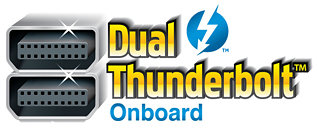
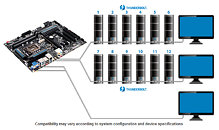
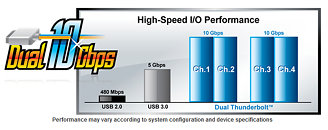



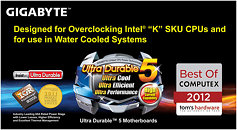
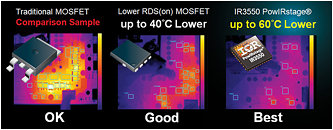
56 Comments on GIGABYTE Launches World's First Fully Certified Dual Port Thunderbolt Motherboards
I can't say I'm interested until Thunderbolt switches to fiber optic.
If you create a USB 4.0, you'll have backwards compatibility with practically every device ever created.
I thought the days of Firewire and the like are over. Back when Firewire was popular, it was far better. Now, the difference between 5Gbps or higher seems a poor reason to create a completely new system that has no compatibility with any device on the market..
My Firewire devices I could plug in and have no issue. Just seemed like the connection was designed with consistent data transfer. Nice n stable with fewer oddities.
Maybe it was just early USB devices and early USB2 chips. My more recent Passport drive and my last iPod both ran decently on USB2/3.
Thunderbolt has a pool of bandwidth like USB, but if I am following that picture right, it has two pools (one per connector) of 20 Gb. Much higher than USB3's 5 Gb and a lot higher than USB2's 480 Mb.
Thunderbolt lanes are like this:
10Gb is for DATA
10Gb is for Video, 2560x1600 requires 7Gbps
so... only 10Gb for data (which is twice that of USB 3.0)
What I'm more interested in is where they're getting their bandwidth from. they either need to tap off PCI Express lanes from the CPU (reducing graphics performance (NO SLI!) or utilize PCI Express lanes from the PCH which are, honestly, already in short supply on Z77 (DMI 2.0 is 4x PCI Express 2.0 or 20GB/s)
Better yet, they could make such a product and INCLUDE Dual thunderbolt capability running off of 8x PCI-e 3.0!
EDIT: Hey they do! But yeah that would be great.
Thunderbolt looks promising :)
Any N/A members looking for bulk cables check partsexpress.com or monoprice.com, they carry just about everything and have great CS! Have dealt with both places.
Sorry for the O/T :o
:toast:
Gigabyte's 7-series mini-ITX boards should be announced next month.
At the demo at computex they used those RAID controllers with a lot of drives, i think those devices are very expensive. I am unsure how well thunderbolt will do, i am sure some MAC users will like them.